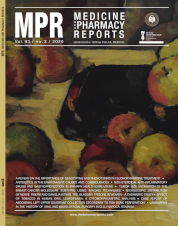Comparative evaluation of the effect of decontamination protocol on the shear bond strength of eighth generation bonding agent to contaminated dentin: an in vitro study
DOI:
https://doi.org/10.15386/mpr-1488Keywords:
contaminants, dentin bonding agents, shear bond strengthAbstract
Introduction. This in vitro study aims to evaluate and compare the effect of decontamination protocol - based on sodium hypochlorite - NaOCl, as a decontaminating agent, followed by the application of a collagen cross-linking agent like sodium ascorbate [Na Ascorbate] or Proanthocyanidin [PA]) on the shear bond strength of eighth generation bonding agent to contaminated dentin (saliva, blood and blood followed by hemostatic agent).
Methodology. The buccal surfaces of extracted premolars were flattened to expose the dentine. The teeth were then randomly divided into 3 groups based on the contaminant used (saliva, blood and blood followed by hemostatic agent). Decontamination protocol was carried out with sodium hypochlorite followed by application of either of the two collagen cross-linking agents (sodium ascorbate/proanthocyanidin) in each group. FuturaBond DC (eighth generation) bonding agent was used to bond composite to dentin surfaces which was subjected to shear bond strength testing. Data was analyzed by one-way ANOVA and Tukey test.
Results All the groups (contaminated with saliva, blood, or hemostatic agent) showed a decrease in shear bond strength of composite resin to dentin. The shear bond strength of composite resin to dentin was least affected by contamination with saliva followed by contamination with blood and was most affected by contamination with a hemostatic agent.
The decontamination protocol carried out showed that the combination of NaOCl and Proanthocyanidin improved the shear bond strength of composite to dentin significantly more than the combination of NaOCl and sodium ascorbate or ofsodium hypochlorite used alone.
Downloads
Published
How to Cite
Issue
Section
License
The authors are required to transfer the copyright of the published paper to the journal. This is done by agreeing to sign the Copyright Assignment Form. Whenever the case, authors are also required to send permissions to reproduce material (such as illustrations) from the copyright holder.

The papers published in the journal are licensed under a Creative Commons Attribution-NonCommercial-NoDerivatives 4.0 International License.

